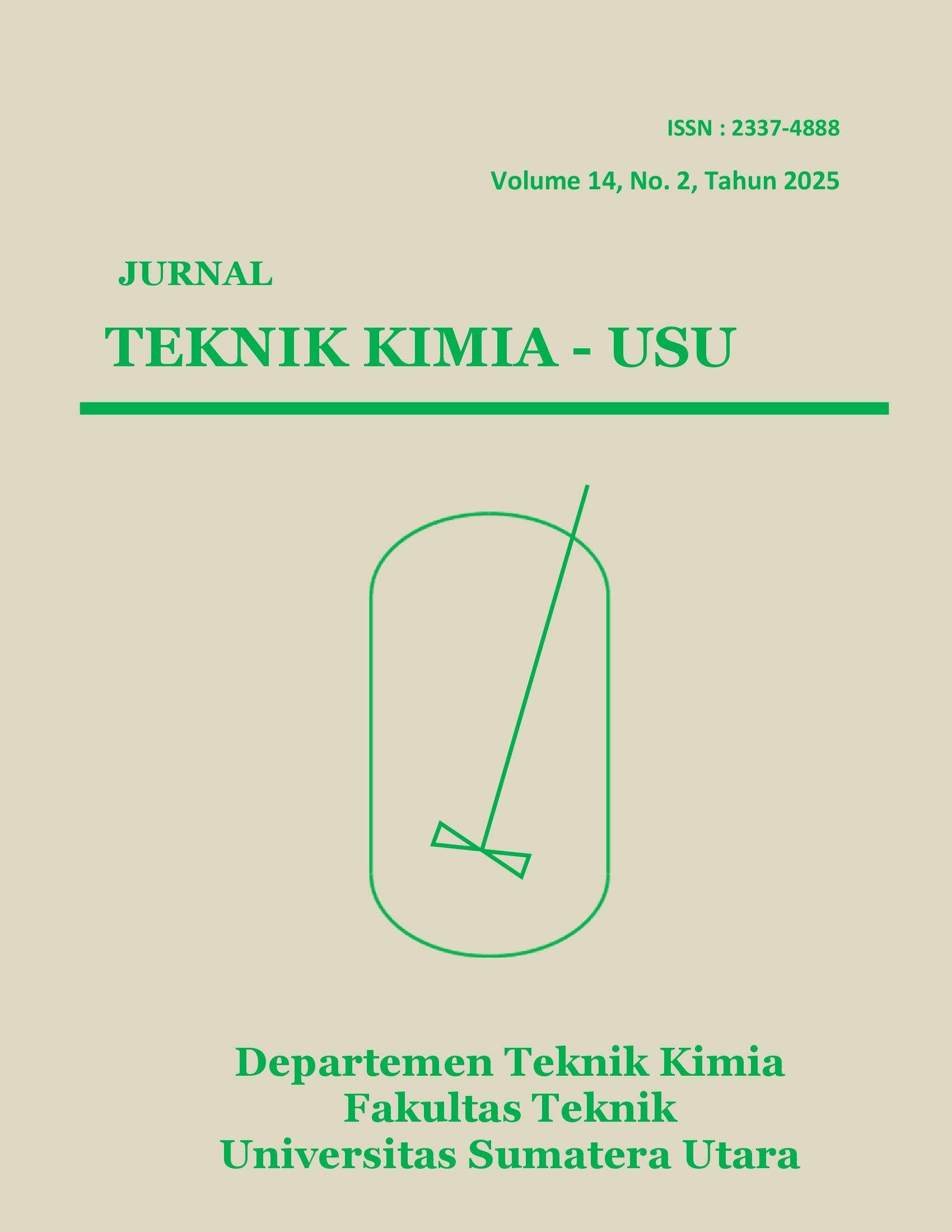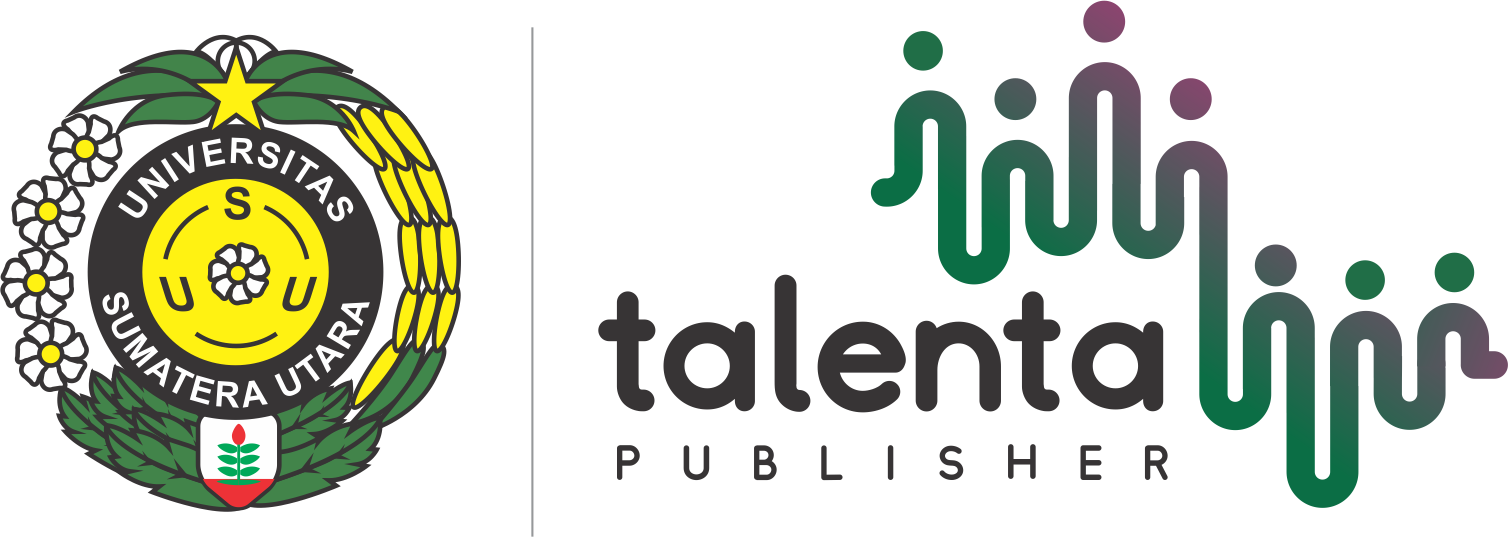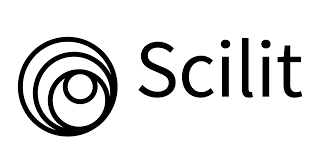Optimasi dan Sintesis Selulosa Dialdehid Berbasis Limbah Tandan Kosong Kelapa Sawit
DOI:
https://doi.org/10.32734/jtk.v14i2.20686Keywords:
oil palm empty fruit bunches powder, oxidation, cellulose, aldehyde, carbonylAbstract
Empty Fruit Bunches of Oil Palm (EFB) represent one of the most problematic biomass wastes in Indonesia due to their massive volume, inefficient management, and underutilization of their chemical potential, leading to significant environmental, economic, and technical impacts. The degradation or processing of such large-scale waste generally requires a long period of time. This study focuses on converting the cellulose content in EFB into dialdehyde cellulose (DAC), which can be applied as a wet strength agent. The aim is to reduce EFB waste by isolating cellulose from EFB biomass and subsequently converting it into DAC, which can be utilized as a wet strength additive in paper or tissue products. The oxidation of EFB cellulose into DAC was optimized using sodium periodate (NaIO₄) as the oxidizing agent, with varying reaction times of 3, 6, and 9 hours. The synthesized DAC was qualitatively analyzed using the Fehling’s test and solubility observations, followed by functional group identification via FTIR and morphological characterization using SEM. Among the samples, DAC-6 exhibited the most optimal characteristics, with a degree of oxidation reaching 82.1% and a carbonyl content of 52.8%. FTIR analysis confirmed the presence of carbonyl functional groups in all DAC samples, indicating successful oxidation of hydroxyl groups in cellulose. DAC-6 showed the most prominent carbonyl absorption peak at a wavenumber of 1748 cm⁻¹.
Downloads
References
N. Aswan et al., “Analisis Regresi Linier dalam Estimasi Produktivitas Kelapa Sawit,” Journal of Social Science Research, vol. 4, pp. 10264–10276, 2024.
“Analisa Usaha Tani Kelapa Sawit Perkebunan Rakyat di Desa Laut Tador Kecamatan Laut Tador Kabupaten Batubara,” JASc (Journal of Agribusiness Sciences), vol. 6, no. 1, Oct. 2022, doi: 10.30596/jasc.v6i1.11710.
A. N. Fitria, V. S. Gunawan, and M. Mardiah, “Study of the Utilization of Palm Oil Industry Liquid Waste,” Konversi, vol. 10, no. 1, Apr. 2021, doi: 10.20527/k.v10i1.10146.
A. M. Fuadi and H. Pranoto, “Pemanfaatan Limbah Tandan Kosong Kelapa Sawit sebagai Bahan Baku Pembuatan Glukosa,” vol. 3, no. 1, pp. 1–5, 2016.
F. E. Gunawan, H. Homma, S. S. Brodjonegoro, A. B. B. Hudin, And A. B. Zainuddin, “Mechanical Properties of Oil Palm Empty Fruit Bunch Fiber,” Journal of Solid Mechanics and Materials Engineering, vol. 3, no. 7, pp. 943–951, 2009, doi: 10.1299/jmmp.3.943.
E. Derman, R. Abdulla, H. Marbawi, M. K. Sabullah, J. A. Gansau, and P. Ravindra, “Simultaneous Saccharification and Fermentation of Empty Fruit Bunches of Palm for Bioethanol Production Using a Microbial Consortium of S. cerevisiae and T. harzianum,” Fermentation, vol. 8, no. 7, Jul. 2022, doi: 10.3390/fermentation8070295.
I. Francolini, L. Galantini, F. Rea, C. Di Cosimo, and P. Di Cosimo, “Polymeric Wet-Strength Agents in the Paper Industry: An Overview of Mechanisms and Current Challenges,” Jun. 01, 2023, Multidisciplinary Digital Publishing Institute (MDPI). doi: 10.3390/ijms24119268.
D. E. Rahayu, N. Karnaningroem, A. Altway, and A. Slamet, “Utilization of Oil Palm Empty Fruit Bunches Biomass through Slow Pyrolysis Process,” Dec. 02, 2021, IOP Publishing Ltd. doi: 10.1088/1755-1315/913/1/012018.
C. L. Yiin et al., “Recovery of Cellulose Fibers from Oil Palm Empty Fruit Bunch for Pulp and Paper using Green Delignification Approach,” Bioresour Technol, vol. 290, Oct. 2019, doi: 10.1016/j.biortech.2019.121797.
A. A. Ulfah, M. Hidayat, R. B. Cahyono, and T. Ariyanto, “The Oxidation of Nanocellulose from Oil Palm Empty Fruit Bunch (OPEFB) by TEMPO/NaClO/NaBr,” ASEAN Journal of Chemical Engineering, vol. 24, no. 3, pp. 328–341, Dec. 2024, doi: 10.22146/ajche.14058.
F. M. Scales, “The Determination of Reducing Sugars: A Volumetric Method for Determining Cuprous Oxide without Removal from Fehling’s Solution,” Journal of Biological Chemistry, vol. 23, no. 1, pp. 81–87, 1915, doi: https://doi.org/10.1016/S0021-9258(18)87603-7.
T. Chiba, M. Takazawa, and K. Fujimoto, “A Simple Method for Estimating Carbonyl Content in Peroxide-Containing Oils,” J Am Oil Chem Soc, vol. 66, no. 11, pp. 1588–1592, 1989, doi: 10.1007/BF02636182.
Z. Tang et al., “TEMPO-Oxidized Cellulose with High Degree of Oxidation,” Polymers (Basel), vol. 9, no. 9, Sep. 2017, doi: 10.3390/polym9090421.
P. R. Sharma and A. J. Varma, “Thermal Stability of Cellulose and Their Nanoparticles: Effect of Incremental Increases in Carboxyl and Aldehyde Groups,” Carbohydr Polym, vol. 114, pp. 339–343, 2014, doi: https://doi.org/10.1016/j.carbpol.2014.08.032.
F. Coppola and A. Modelli, “Oxidative Degradation of Non-Recycled and Recycled Paper,” Cellulose, vol. 27, no. 15, pp. 8977–8987, 2020, doi: 10.1007/s10570-020-03395-0.
J. Simon et al., “A Fast Method to Measure the Degree of Oxidation of Dialdehyde Celluloses using Multivariate Calibration and Infrared Spectroscopy,” Carbohydr Polym, vol. 278, p. 118887, 2022, doi: https://doi.org/10.1016/j.carbpol.2021.118887.
Q. Tu et al., “Characteristics of Dialdehyde Cellulose Nanofibrils Derived from Cotton Linter Fibers and Wood Fibers,” Molecules, vol. 29, no. 7, Apr. 2024, doi: 10.3390/molecules29071664.
T. Chaiwarit et al., “Synthesis of Carboxylate-Dialdehyde Cellulose to Use as a Component in Composite Thin Films for an Antibacterial Material in Wound Dressing,” ACS Omega, vol. 9, no. 44, pp. 44825–44836, Nov. 2024, doi: 10.1021/acsomega.4c08298.
A. Lucia, H. W. G. van Herwijnen, J. T. Oberlerchner, T. Rosenau, and M. Beaumont, “Resource-Saving Production of Dialdehyde Cellulose: Optimization of the Process at High Pulp Consistency,” ChemSusChem, vol. 12, no. 20, pp. 4679–4684, Oct. 2019, doi: https://doi.org/10.1002/cssc.201901885.
C. Lin et al., “Preparation of Highly Hazy Transparent Cellulose Film from Dissolving Pulp,” Cellulose, vol. 26, no. 6, pp. 4061–4069, 2019, doi: 10.1007/s10570-019-02367-3.
Downloads
Published
Issue
Section
License
Copyright (c) 2025 Jurnal Teknik Kimia USU

This work is licensed under a Creative Commons Attribution-ShareAlike 4.0 International License.

















